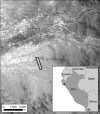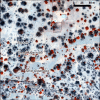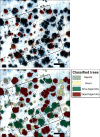Identifying species from the air: UAVs and the very high resolution challenge for plant conservation
- PMID: 29176860
- PMCID: PMC5703556
- DOI: 10.1371/journal.pone.0188714
Identifying species from the air: UAVs and the very high resolution challenge for plant conservation
Abstract
The Pacific Equatorial dry forest of Northern Peru is recognised for its unique endemic biodiversity. Although highly threatened the forest provides livelihoods and ecosystem services to local communities. As agro-industrial expansion and climatic variation transform the region, close ecosystem monitoring is essential for viable adaptation strategies. UAVs offer an affordable alternative to satellites in obtaining both colour and near infrared imagery to meet the specific requirements of spatial and temporal resolution of a monitoring system. Combining this with their capacity to produce three dimensional models of the environment provides an invaluable tool for species level monitoring. Here we demonstrate that object-based image analysis of very high resolution UAV images can identify and quantify keystone tree species and their health across wide heterogeneous landscapes. The analysis exposes the state of the vegetation and serves as a baseline for monitoring and adaptive implementation of community based conservation and restoration in the area.
Conflict of interest statement
Figures








References
-
- Linares-Palomino R, Kvist LP, Aguirre-Mendoza Z, Gonzales-Inca C. Diversity and endemism of woody plant species in the Equatorial Pacific seasonally dry forests. Biodivers Conserv. 2009;19: 169–185. doi: 10.1007/s10531-009-9713-4 - DOI
-
- Banda K, Delgado-Salinas A, Dexter KG, Linares-Palomino R, Oliveira-Filho A, Prado D, et al. Plant diversity patterns in neotropical dry forests and their conservation implications. Science (80-). American Association for the Advancement of Science; 2016;353: 1383–1387. - PubMed
-
- Lerner Martínez T, Ceroni Stuva A, González Romo CE. Etnobotánica de la comunidad campesina”Santa Catalina de Chongoyape” en el Bosque seco del área de conservación privada Chaparrí-Lambayeque. Ecol Apl. Universidad Nacional Agraria La Molina; 2003;2: 14–20.
-
- Holmgren M, Stapp P, Dickman CR, Gracia C, Graham S, Gutierrez JR, et al. Extreme climatic events shape arid and semiarid ecosystems. Front Ecol Environ. 2006;4: 87–95. doi: 10.1890/1540-9295(2006)004[0087:ECESAA]2.0.CO;2 - DOI
-
- Palacios RA, Burghardt AD, Frías-Hernández JT, Olalde-Portugal V, Grados N, Alban L, et al. Comparative study (AFLP and morphology) of three species of Prosopis of the Section Algarobia: P. juliflora, P. pallida, and P. limensis. Evidence for resolution of the “P. pallida-P. juliflora complex.” Plant Syst Evol. 2012;298: 165–171. doi: 10.1007/s00606-011-0535-y - DOI
MeSH terms
LinkOut - more resources
Full Text Sources
Other Literature Sources
Research Materials

